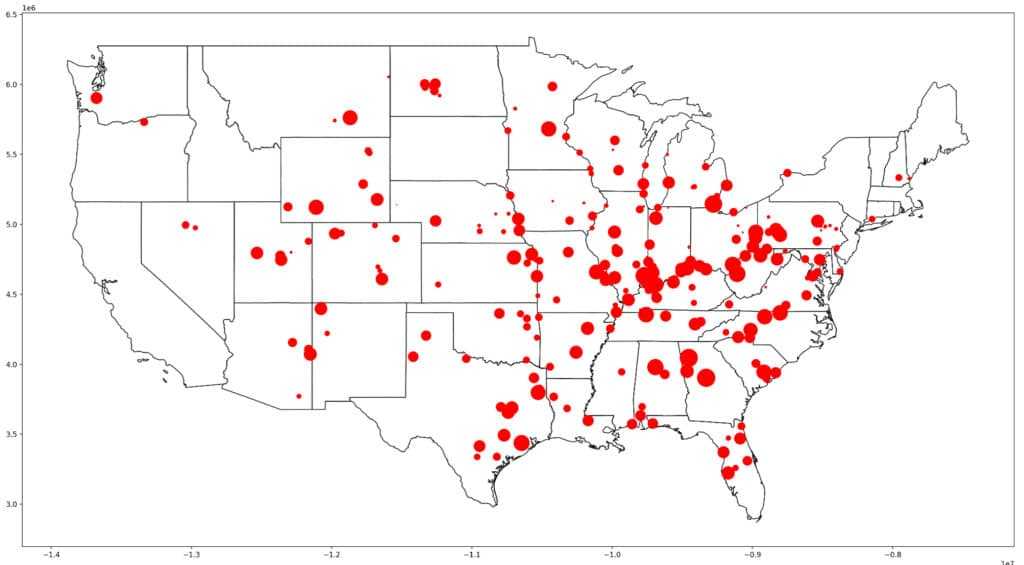Coal-fired power plants in the United States. Bubbles are scaled by plant capacity, which ranges from 5 to 3,500 MW. Image credit: From Vanatta et al. in iScience, August 2022.
A new study from the University of Michigan shows that local wind and solar jobs can fully replace the coal plant jobs that will be lost as the nation shifts from coal to clean energy for power generation over the next few decades. In 2019, 80,000 workers at more than 250 plants in 43 U.S. states were still employed in coal-fired electricity generating plants and operations. This new study shows the technical feasability and costs of replacing those jobs with local wind and solar energy jobs, and quantifies how that can happen.
The study was published yesterday in the peer-reviewed journal iScience, concluding that local wind and solar jobs can fill the electricity generation and employment gap, even while restricting those jobs to be within 50 miles of the lost job they replace.
Keeping employment local would increase the costs of replacing U.S. coal-plant workers by $83 billion, or 24%, nationwide, according to the study. "These costs are significant in isolation but are small relative to annual U.S. power investments of $70 billion and to the total costs of transitioning the U.S. energy system away from fossil fuels, which have been estimated to be as high as $900 billion by 2030," said study senior author Michael Craig of U-M's School for Environment and Sustainability.
"Our results indicate that replacing lost jobs in coal-plant communities would modestly increase overall energy-transition costs while significantly furthering a just transition for one category of frontline communities," said Craig, assistant professor of energy systems and an expert on power system emissions, operations and planning.
The U-M researchers suggest that federal policymakers could introduce a new investment tax credit to help defray the costs of transitioning to renewables. This type of credit would only apply to wind and solar projects located near retiring coal plants that employ retrained coal-plant workers, to encourage retraining and continued employment of workers in the energy sector.
Electric power is the cheapest sector to decarbonize in order to mitigate climate change in the aggressive manner now required to halt its progression. Much of U.S. emissions reductions have come from that sector so far. The U.S. plan for decarbonization rests in part on retiring coal plants and replacing them with clean locally sourced energy production. No previous study had quantified how feasible that plan is and how to make that happen without major employment disruption in the energy sector.
This photo, courtesy of SkySpecs, shows a drone inspecting a wind turbine, part of a vast offshore installation of clean energy producing turbines that will help the U.S. and the world wean off coal energy to mitigate climate change.
The study assumes a full phase-out of U.S. coal-fired electricity generation plants by 2030 and applies a bottom-up optimization model to all coal plants in the contiguous United States. Every coal plant that is retired then requires new renewable energy investments to replace both the electricity generated and the employment provided by the factory.
The researchers analyzed three "siting limits": the maximum distance that replacement solar and wind facilities can be located relative to a retiring coal plant: 50 miles, 500 miles and 1,000 miles. The 50-mile limit approximates local solar and wind facilities and jobs that would not require relocation of coal plant workers, while the 1,000-mile distance limit would require relocation of workers to new plants. The study found that for all regions and for all siting limits, retiring coal plants replaced with a mix of wind and solar power could also fully replace jobs. Operations and maintenance jobs account for 57-92% of replacement employment at wind and solar facilities, while construction jobs play a more minor role in the mix.
The study did not account for the tendency in the interim to lean on natural gas production and how the use of existing assets could reduce renewable energy jobs. The study also did not account for the impact of workforce retraining requirements on coal plant workers.
If you would like to see the study you can find it below.
The first author of the iScience study is Max Vanatta of the U-M School for Environment and Sustainability. Other authors are Bhavesh Rathod of SEAS, Julian Florez of the U-M Department of Industrial and Operations Engineering, Isaac Bromley-Dulfano of the U-M Department of Electrical Engineering and Computer Science, and Dylan Smith of U-M's Applied Physics Program. Funding for the research was provided by the Idaho National Laboratory's Emerging Energy Markets Analysis Initiative and by the U-M School for Environment and Sustainability.


